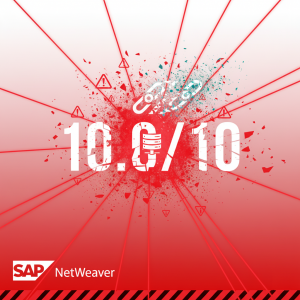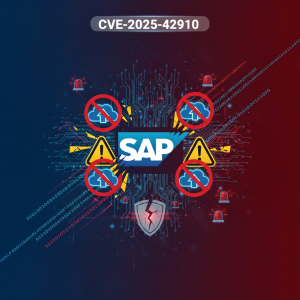Critical Hard-Coded Credentials Vulnerability in SQL Anywhere Monitor (Non-GUI)
10.0
CRITICAL
HotNews
Nov 11, 2025
🚨 Critical Alert
IMMEDIATE ACTION REQUIRED: SQL Anywhere Monitor contains hardcoded credentials that allow unauthenticated remote attackers to achieve arbitrary code execution with complete system compromise.
- Attack Vector: Network (Remote)
- Authentication: None Required
- Impact: Complete System Compromise (CIA Triad: HIGH/HIGH/HIGH)
- Exploitation: Active exploitation possible
Executive Summary
SAP SQL Anywhere Monitor (Non-GUI) version 17.0 contains hardcoded credentials embedded directly in the application code, specifically in the migrator.jar file. These credentials provide unauthenticated attackers with the ability to access the monitoring database (samonitor.db) and execute arbitrary code without any authentication requirements.
The vulnerability exists because SAP distributed a pre-configured monitoring database with default credentials that were never meant to be changed by users. This poses a maximum severity risk (CVSS 10.0) as it allows complete system takeover from remote attackers over the network.
Vulnerability Details
Hard-Coded Credentials in SQL Anywhere Monitor
Affected Component: SAP SQL Anywhere Monitor (Non-GUI)
Affected Versions: SQL Anywhere 17.0 (all builds prior to 17.0 SP1 PL20 Build 8039)
SAP Note: 3666261
Technical Analysis
The vulnerability stems from hardcoded database credentials embedded in the com.ianywhere.serverMonitor.migrator.MonitorMigrator Java class within migrator.jar. The credentials are used to construct JDBC connection strings for accessing the SQL Anywhere Monitor database.
Evidence: Hardcoded Credentials Found
Location: migrator.jar → com/ianywhere/serverMonitor/migrator/MonitorMigrator.class
Hex Dump Evidence:
Username (UID): Hex: 3b 55 49 44 3d 01 00 04 6d 64 62 61 ASCII: ;UID=....mdba Value: mdba Password (PWD): Hex: 3b 50 57 44 3d 01 00 52 45 44 52 41 59 53 ASCII: ;PWD=....sql%REDACTED% Value: sql%REDACTED%
JDBC Connection String Pattern:
jdbc:sql%REDACTED%where:START=dbsrv17 -gd all -hV;ENG=...; DBF=...;DBN=samon_src;UID=mdba;ASTART=YES jdbc:sql%REDACTED%where:ENG=samon_dest;PWD=sql%REDACTED%
Attack Scenario
- Attacker identifies SQL Anywhere 17.0 installation with Monitor enabled
- Attacker connects to the monitoring database using credentials:
mdba/sql%REDACTED% - Attacker gains full database access and can execute arbitrary SQL commands
- Through database access, attacker achieves code execution on the host system
- Complete system compromise with access to all data and system resources
Impact Assessment
- Confidentiality: HIGH - Complete access to monitoring data and potentially all database content
- Integrity: HIGH - Ability to modify database content, configuration, and system files
- Availability: HIGH - Capability to disrupt or destroy database and monitoring services
- Scope: CHANGED - Impact extends beyond the vulnerable component to connected systems
Root Cause Analysis
Why This Vulnerability Exists
According to SAP Note 3666261, the SQL Anywhere Monitor was provided as a mitigation for Adobe Flash deprecation. To allow users to continue using monitoring functionality without migrating to SQL Anywhere Cockpit, SAP included a pre-configured monitoring database (samonitor.db) with the installation package.
The Problem: This pre-configured database was distributed with hardcoded default credentials that were never intended to be changed by end users. Environments that deployed SQL Anywhere Monitor without implementing additional security controls were left vulnerable to unauthorized access.
Fix Analysis: Build 8038 → Build 8039
Changes Between Vulnerable and Patched Versions
Build 8038 (VULNERABLE)
samonitor.db(5.9 MB) - Pre-configured database with credentialssamonitor.db1- Transaction logmigrator.jar(60 KB) - Contains hardcoded credentials- Monitor fully functional with default credentials
Build 8039 (PATCHED)
samonitor.sql(18 KB) - Schema definition onlysamonitor.sql1- Empty schema templatemigrator.jar(58 KB) - Credentials removed- Monitor database completely removed
Mitigation Strategy
SAP's fix takes a complete removal approach rather than attempting to change default credentials. The patch:
- Removes the pre-configured
samonitor.dbdatabase entirely from the distribution - Provides only SQL schema definitions (
samonitor.sql) for manual database creation - Updates
migrator.jarto remove hardcoded credentials - Forces administrators to manually create monitoring databases with unique credentials
- Deletes existing monitor databases during patch installation (with data unload option)
Remediation Actions
Immediate Actions Required
Priority 1: Emergency Patch Deployment
Download: SAP Software Downloads
Documentation: SAP Note 3666261
Priority 2: Immediate Workaround (If Patching Not Immediately Possible)
# Stop SQL Anywhere Monitor service
dbstop -c "ENG=samonitor;UID=dba;PWD=sql"
# Locate and delete all samonitor database files
find / -name "samonitor*.db" -type f -delete
find / -name "samonitor*.log" -type f -delete
# Verify deletion
find / -name "samonitor*" -type f
Priority 3: Network-Level Protection
- Block network access to SQL Anywhere Monitor ports (default: TCP 2638, 2639)
- Implement firewall rules restricting access to trusted management networks only
- Enable network-level authentication and encryption (TLS)
- Monitor for suspicious connection attempts to monitoring database
Priority 4: Migration Path
SQL Anywhere Cockpit provides modern monitoring capabilities without the security risks of the deprecated Monitor component.
Detection and Verification
Check for Vulnerable Systems
1. Identify SQL Anywhere Installations
# Check SQL Anywhere version
dbversion -q
# Vulnerable if output shows: Version 17.0 Build < 8039
2. Check for Monitor Database Files
# Search for samonitor database files
find /opt/sql%REDACTED%where17 -name "samonitor.db"
dir C:\SAP\sql%REDACTED%where17 /s /b | findstr samonitor.db
# If files exist: VULNERABLE
3. Verify Patch Installation
# After patching, verify:
ls -la *samonitor*
# Expected output (Build 8039+):
# samonitor.sql (schema only, ~18KB)
# NO samonitor.db files should exist
4. Security Audit
- Review firewall logs for unauthorized connection attempts to ports 2638, 2639
- Check SQL Anywhere audit logs for suspicious authentication attempts
- Search for user accounts:
mdba,dbawith recent activity - Review application logs for unusual database queries or admin operations
Timeline
References and Resources
- SAP Security Note 3666261 — Official SAP security advisory
- CVE-2025-42890 — CVE database entry
- SAP Software Downloads — Download patched version
- SQL Anywhere 17.0 Documentation — Product documentation
- Component: BC-SYB-SQA-ADM (SQL Anywhere - Admin Tools)
- Affected Versions: SYBASE_SQL_ANYWHERE_SERVER 17.0






